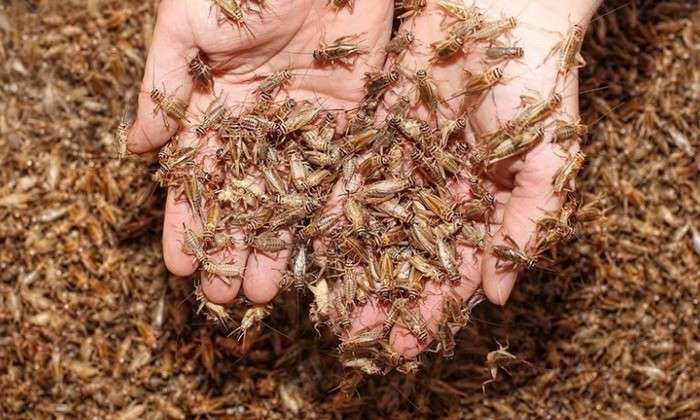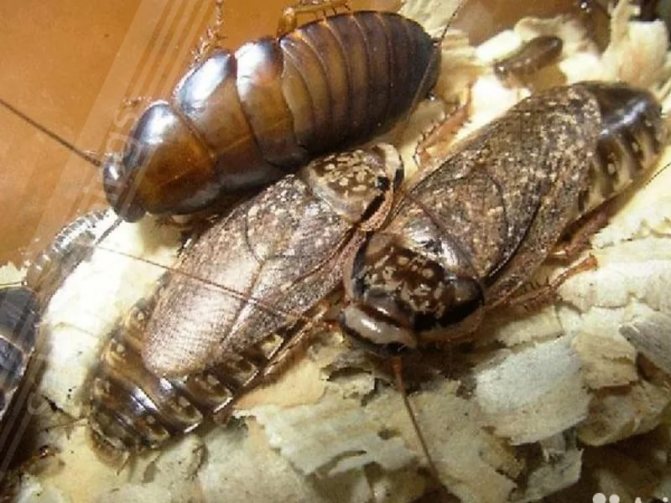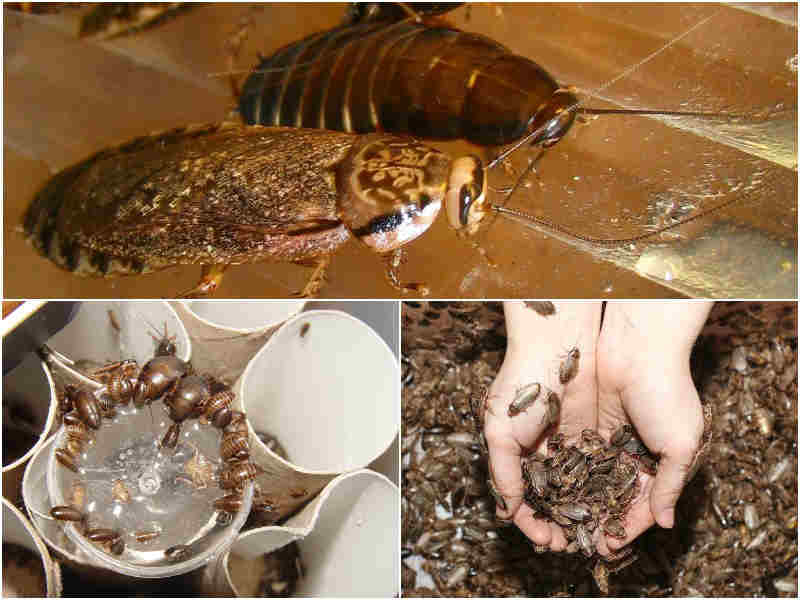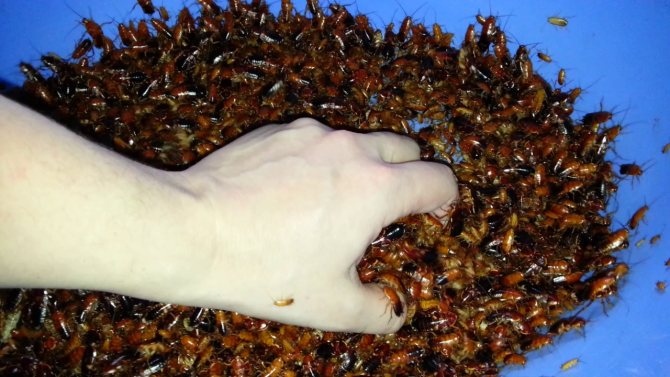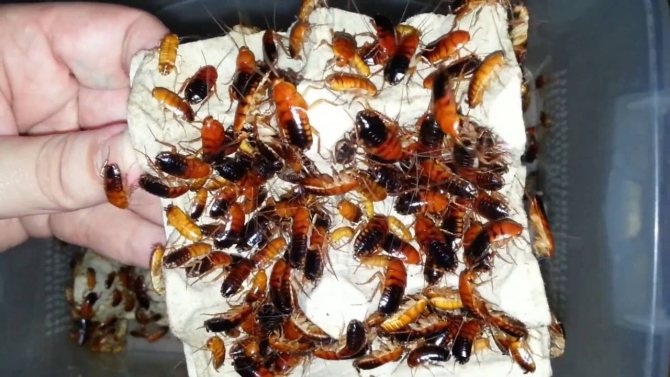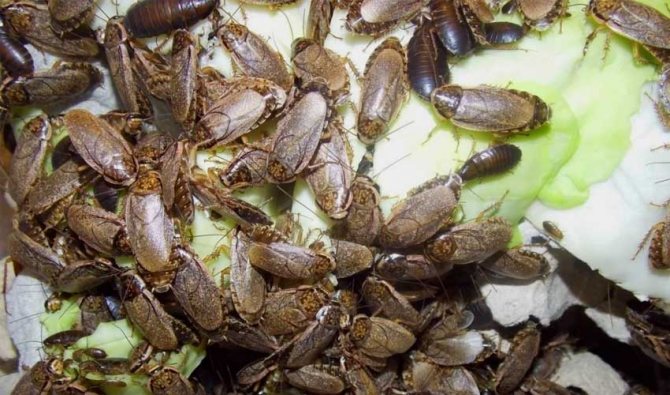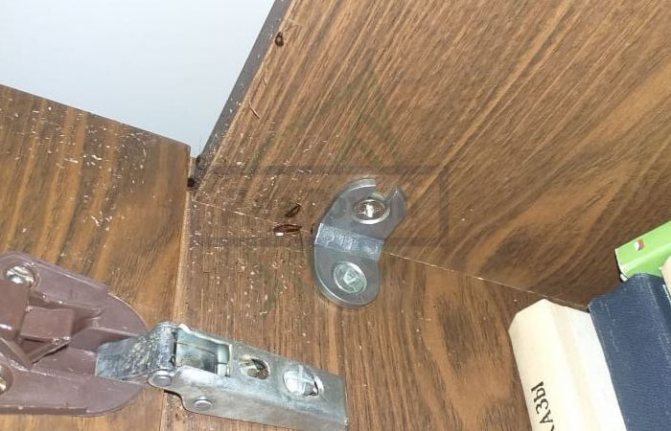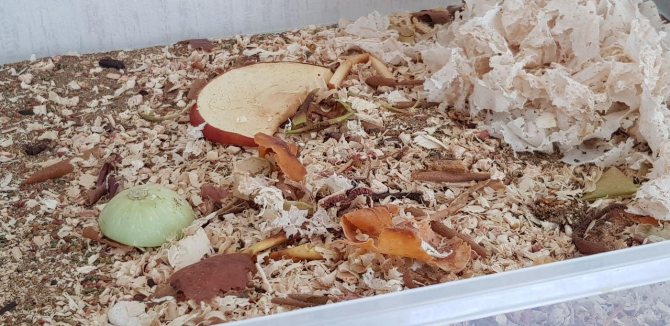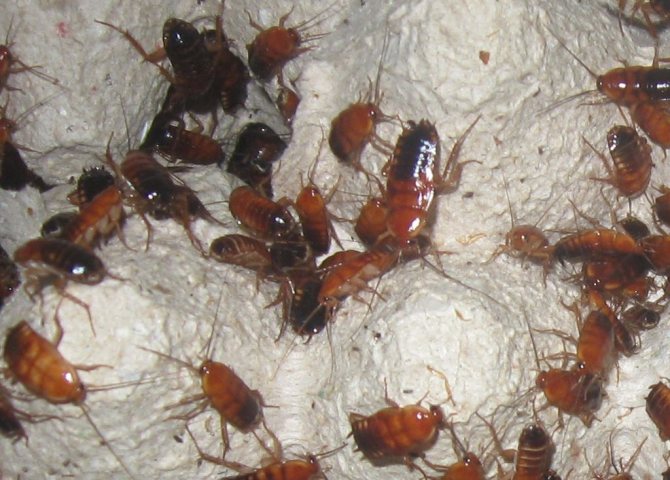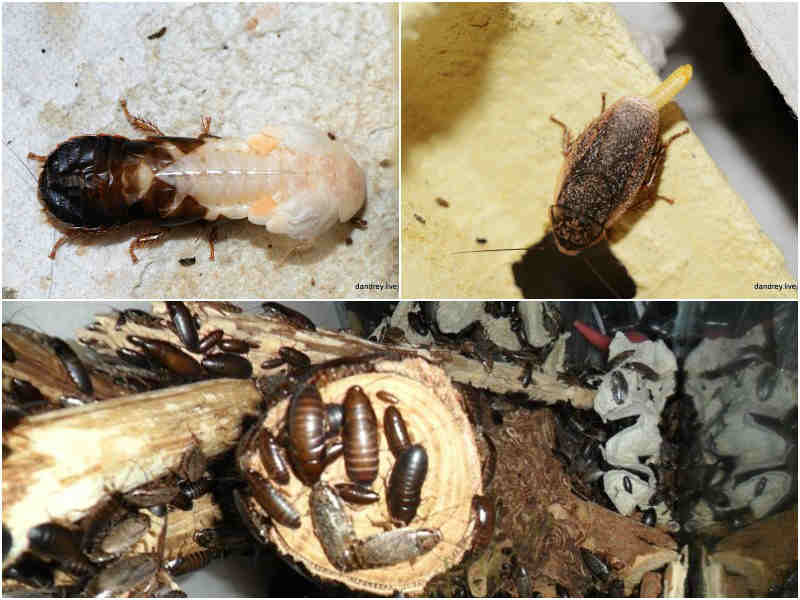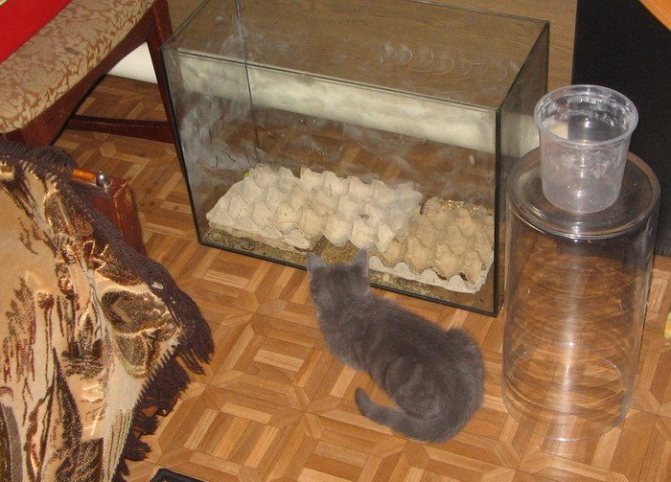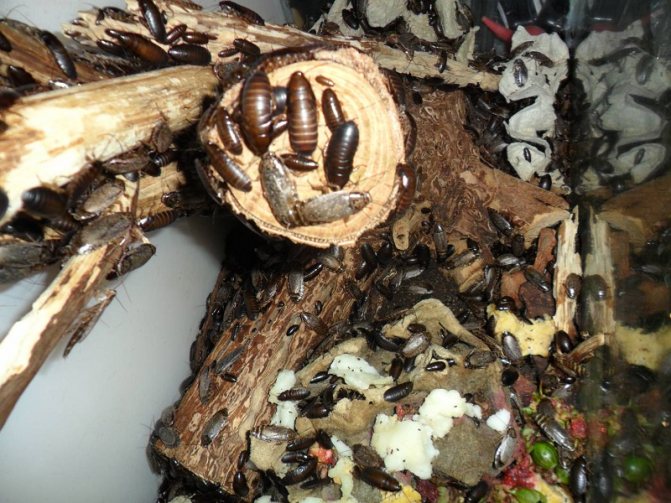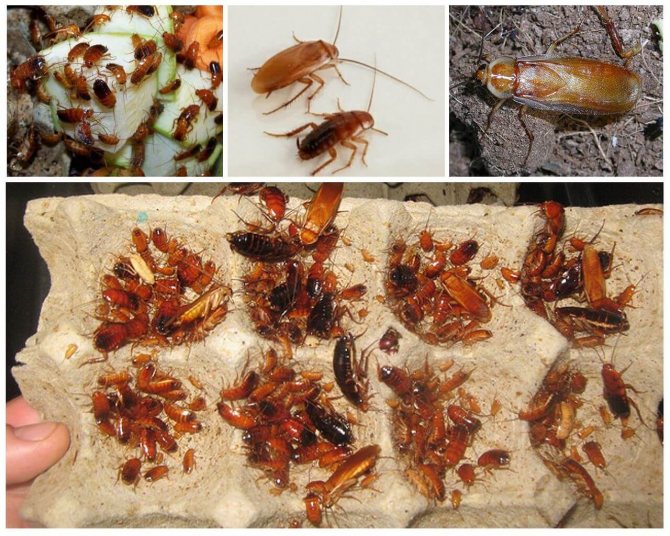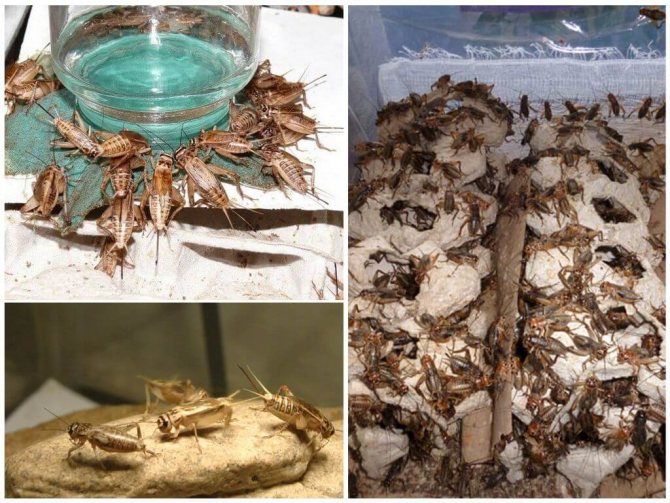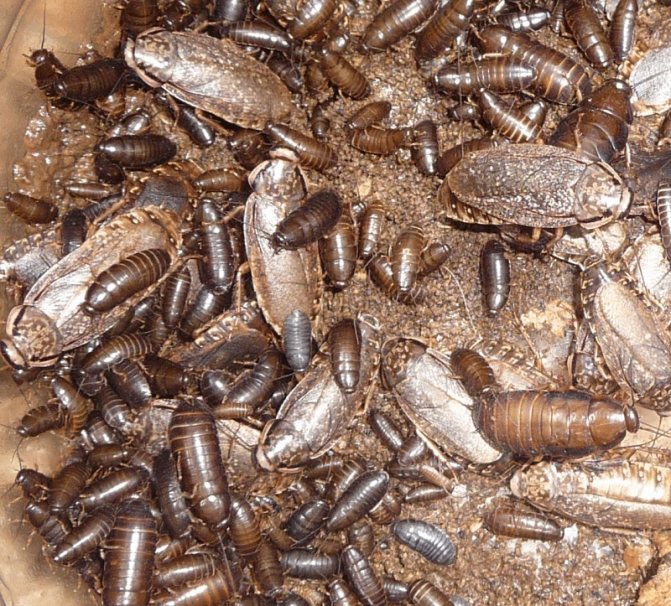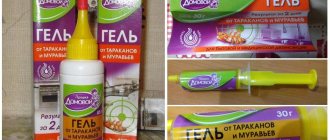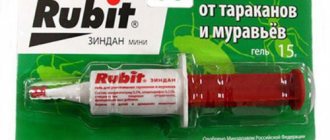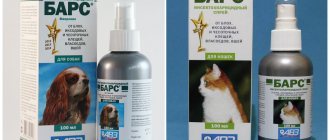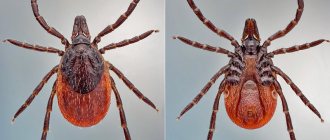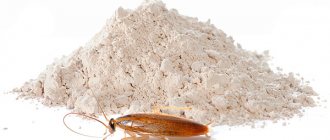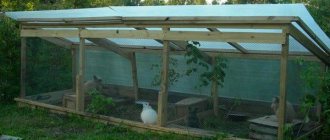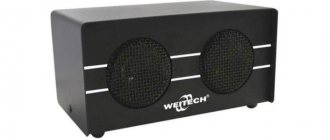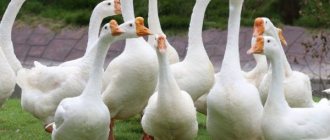The order of cockroaches is huge and has up to 2000 species. We are used to considering them as domestic parasites: even the appearance of a Prusak evokes negativity and a desire to destroy it as soon as possible. But among this variety, there are quite cute individuals that are raised as pets and used as food. Among these "beauties" are marble cockroaches - exotic representatives of the order of cockroaches.
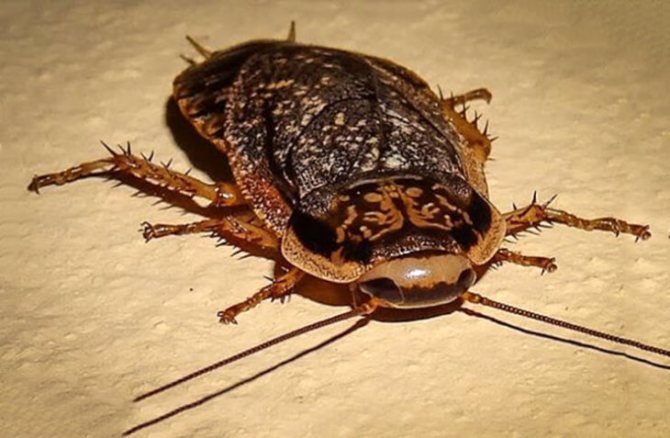
Who is he
This insect has several names. He is also called the ash cockroach, naufeta. He comes from tropical countries. They spread throughout the world due to their unpretentiousness and vitality. They are not afraid of low temperatures, dry air and poor quality feed. Many insecticides also cannot harm these insects.
Marble cockroaches are almost indistinguishable from their relatives. Their length is about three centimeters. Females are slightly larger than males. There are wings, but they cannot fly. They are not afraid of hunger. Without food, they will live for several days. You don't have to look for special feed either. Naufeta is omnivorous. They live for about ten months.


The ash cockroach cannot be called a beautiful exotic insect, but, as food, it is rich in proteins and other nutrients that are necessary for the life of larger animals.
Naufeta refers to:
- type - arthropods;
- class - insects;
- to the detachment - cockroaches;
- mind - Nauphoeta cinerea.
How to breed and care
Terrarium owners are extremely interested in breeding Nauphoeta cinerea in their home so that they have live, and therefore fresh, nutritious food on hand. A number of requirements must be met to keep the neophytes.
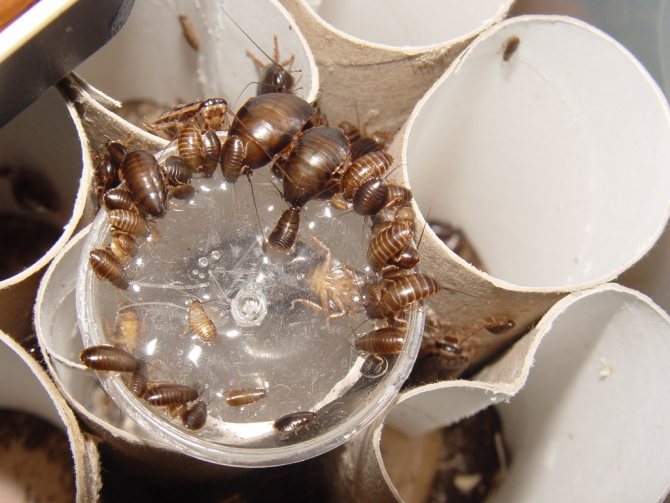

Insectarium: aquarium or plastic box with a tight lid
- An insectarium or a dwelling for insects can be built out of a box, or even better from an aquarium, the height of the walls of which should not be less than 200 mm. Comfortable conditions of detention: temperature 25-30 degrees and relative humidity of about 60%. In cold weather, the dwelling should be placed near a heating radiator or warmed up living creatures from above with a lamp. And in order to provide the required humidity, the container is processed in a finely dispersed way at least 2 times a day. It is necessary to take into account the fact that cockroaches perfectly climb up strictly vertical surfaces, and, even upside down, run quickly. Therefore, the upper edges of the container by 5-7 cm should be treated with petroleum jelly, preventing insects from escaping in the event of a temporary open lid. The rest of the time, it should fit snugly against the frame. With an overgrown population and untreated edges of a box or aquarium, individuals gathered at its edge can easily lift a plastic or even glass lid. This is fraught with shoots, after which it is very problematic for insects to return to their house.
- Breathing inside cockroaches should be provided with small drilled holes (up to 1.0 mm in diameter) to allow sufficient air to pass through. They become an obstacle for nymphs trying to get out. No gaps are allowed.
- It is rational to start breeding live food from at least 20, and preferably from 50 individuals.If you plan not to buy cockroaches for constant replenishment, but to do with your own capabilities, you need to monitor their selection for feeding and leave them for procreation. To do this, according to a certain scheme, insects of one or the other sex are given for food. First, there are males, until there are 1 or 2 of them left. Then the females are fed. Ultimately, the "untouchable minimum" is 2 or 3 females and 1 or 2 males. They revive the population again. For active reproduction, the aquarium or box is placed in a dark place: insects are especially active without light. In order to raise the weakened vitality of the offspring of marbled, it is practiced to infuse "fresh blood" into their population: to plant individuals of both sexes from other colonies. For comfortable living conditions, it is necessary that the density of ash cockroaches for each centimeter of the area be one individual.
Attention! With an uncontrolled process, reproduction takes place actively, there is more material for feed than needed. It is necessary to monitor this and, when a critical amount is reached, lower the temperature of the habitat, thereby stopping the reproduction process.
About nutrition
Let's talk about how the insect feeds. As mentioned above, ash cockroaches are happy to eat everything that they come across on the road: cheese, bread, vegetables, fruits. In the wild, they eat smaller insects. At home, marble cockroaches are grown to feed other animals, which means they must have nutritional value.
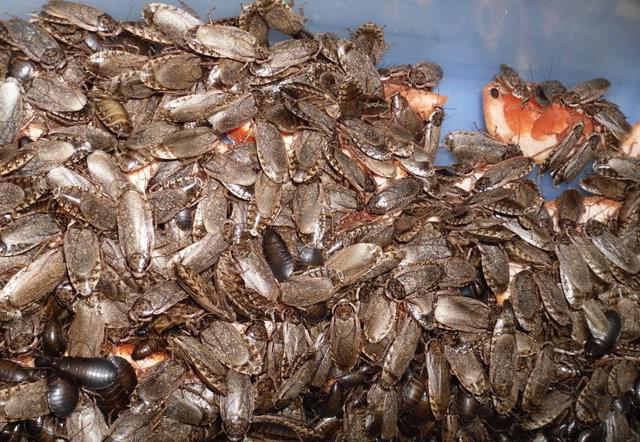

The owners feed them:
- Protein products: dry food for fish and cats, eggs, low-fat cottage cheese, bloodworms, leftovers from meat dishes.
- Groats, mixed feed, bran.
- Bakery products.
- Cabbage, salad leaves, beets.
- Apples and pears.
- Flowers and herbs.
Bananas, tomatoes, nuts, bacon, cheese should not be given to insects. Carbohydrate and protein foods should not be mixed. For these purposes, you will need two feeders. The feed is renewed after three or four days.
If you do not adhere to these rules, then naufets may die ahead of time. No matter how omnivorous they are, there are foods that will harm them.
Development and life cycle
Cockroaches are insects with incomplete transformation. Their newborn nymphs look exactly the same as adults, with a few minor differences (for example, lack of wings). These nymphs shed their skin (molt) every few weeks and move on to the next larval stage. Newborn larvae are called nymphs L1, which have passed the first molt - L2 and so on, until they become adults. Adults can be identified by the presence of wings: nymphs do not have wings, while adults do. Some species have no wings at all, even in adults.
Cockroach eggs are found in capsules called ootecs. They are made of foam that protects the eggs. Some species drop the ooteca on the ground, others are glued in their chosen place, and still others are kept inside the body until the nymphs hatch.
House for insects
It is called an insectarium for cockroaches. True, many say that it is not necessary to spend money on its purchase. A plastic container is perfect for these purposes. It can be purchased without any problems at a hardware store. Remember, the wall should be high, at least thirty centimeters. The cover is not required, insects will not scatter. Although they have wings, they cannot fly and climb. Wings are given to them in order to glide from a height.
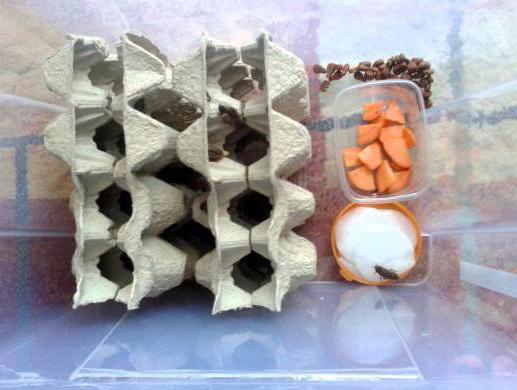

For reliability, the walls of the house from the inside can be greased with thick petroleum jelly. Vaseline oil cannot be used, it will spread along the walls. The strip should be about four centimeters wide from the top of the container. Insects will not be able to overcome this obstacle. This protection is updated once every two months.Before applying a new layer, the old one must be removed using a paper towel or cloth. The Vaseline strip must be clean, free of dust and dirt.
General description of cockroaches
There are more than 3500 species of cockroaches (50 are considered pests, of which a small part lives in houses). It is believed that cockroaches carry about 40 types of infection and disease.


The body of cockroaches is oval, very flattened, this allows them to climb into narrow places. Cockroaches have powerful legs that allow them to run fast. There are species that can fly. The cockroach's head is hidden (protected by a neck shield) and faces downward. After molting, like most insects, cockroaches are white until the salts in the new skin are oxidized. Old skin is often eaten.
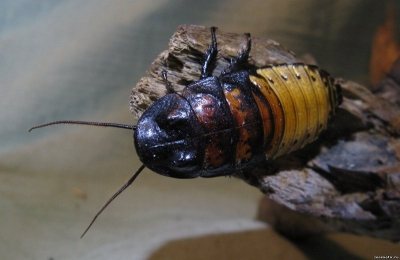

Megaloblatta blaberoides is the largest cockroach species (body: 100 mm, wingspan: 180 mm). Macropanesthia rhinoceros is a burrowing cockroach, it is not far behind Megaloblatta blaberoides, its weight is 35 grams more, but also 15 mm less in height. Cockroaches are nocturnal insects. In case of danger, they make a sound (can reach 60 decibels), losing paws against each other.
Keeping and breeding cockroaches.
Cockroaches are considered a relatively easy crop to cultivate, but there are a few nuances to look out for:
1. Correct feeding;
2. Regular care;
3. The appropriate terrarium for this type and its design and equipment.
Feeding cockroaches.
In order for the cockroach colony to develop normally, it is necessary to constantly feed and remove their waste products in a timely manner. For most cockroach species, the following diet is more fully suitable as food - sifted bran, oatmeal, dry hamarus, mashed or soaked white bread crackers, grated or finely chopped fruits or vegetables. The differences lie only in the proportion of this or that feed. For example, Madagascar cockroaches prefer fruits and vegetables, and black cockroaches prefer oatmeal or white bread. Food is laid out in low feeders in portions, depending on the number of cockroaches in the colony. In this case, wet and dry food is best separated, since dry food can be stored for a rather long time, unlike wet food, which quickly deteriorate and mold at high temperature and humidity. You should also adhere to the principle - it is better to feed less, but more often than more, but rarely. Throw away the leftover feed leftovers, wash the feeder thoroughly, otherwise even fresh feed can quickly become moldy. It should be remembered that during feeding, cockroaches are pulled away by cockroaches in all corners of the terrarium - as a result, the soil deteriorates, therefore, if possible, scattered remains should be picked up. In addition to spoiled soil, with scattered residues, a tick can begin to breed, which in the shortest time can destroy the entire colony.
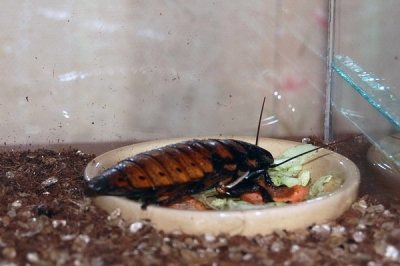

For some small species of cockroaches, the use of a feeder is not entirely convenient, since their larvae are rather small and are not always able to get to the food, in such cases, the food should be poured onto the ground or onto pieces of bark. In this case, you should replace the food as often as possible, removing it with part of the soil. In addition to these foods, some cockroach species should be supplemented with large amounts of calcium. This is due to the fact that some species, such as the black cockroach / Argentine cockroach, naturally inhabit rocky limestone outcrops and do not tolerate acidic soils (peat) well. As a limestone top dressing, you can use the shell of a chicken egg, which should be cleaned of protein and film, and then crushed in a coffee grinder. This shell dressing can be sprinkled on both feed and soil.
Food in the terrarium must be present at all times, both wet and dry.Otherwise, freshly moulted individuals will be attacked by hungry brethren, in addition, at a high population density, there have been cases of juvenile eating by adult cockroaches.
Selection of terrariums for cockroaches.
Glass, plexiglass or plastic containers with metal top ventilation are suitable as a terrarium or cockroach cage to prevent fry from escaping. Side-lid designs are not suitable for keeping cockroaches as all species are quite mobile, especially when disturbed. Therefore, it will be difficult to work at a time when some of them will run away.
For species that are able to move on vertical surfaces, an obstacle should be erected from the upper parts of the walls in the form of a thin layer of petroleum jelly 4-6 cm wide, since cockroaches cannot move along vertical surfaces smeared with petroleum jelly. This procedure should be repeated 1-2 times every six months. If silicone glue is used when gluing a stele terrarium, the edges of the glasses should be well adjusted. If the glasses are loosely fitted to each other and the gaps between them are filled with silicone, then some types of cockroaches (for example, Turkmen or black) can gnaw it and get out.
The size of the cage should be selected according to the species and size of the colony.
Terrarium decoration for cockroaches.
The design of a terrarium for cockroaches directly depends on the type and purpose of the colony (demonstrative or forage). Many species of cockroaches lead a burrowing way of life, so they need a layer of loose substrate 4-10 cm thick. Large sawdust of non-coniferous trees is usually used as a substrate. For breeding forage cockroaches, such as marble, Turkmen, Madagascar - 2-3 cm of the substrate will be enough.
One of the best substrates for all display species of cockroaches, according to many amateurs, is pure top peat. It absorbs excess moisture well, in addition, with good illumination, an aesthetic appearance is created, which is not unimportant for exposure. To create a looser consistency, dry oak leaves, rot, wood dust, sawdust can be added to the peat. And to decorate the terrarium, you can use driftwood and bark of non-coniferous trees, having previously scalded with boiling water - this is done in order to kill unwanted arthropods and slow down the decay process. Driftwood is best harvested from peat extraction sites.
For large winged species such as Blaberus and Archimandrita, bark and driftwood should be positioned vertically, as adults and molting larvae prefer a vertical surface. For other species, bark and driftwood can be smoothed horizontally, leaving gaps for shelter.
Conditions for keeping cockroaches.
In order for cockroaches to grow well and molt without problems, you should monitor the temperature and humidity inside the terrarium. Most types of cockroaches require humidity in the range of 50-70%. Humidity is maintained in the following ways:
1. Moderate spraying from a puliviser.
2. Installation of several drinkers with a low water level, approximately 1-2 mm.
3. Decreased ventilation.
The latter method is more suitable for forest cockroach species (Panchlora nivea).
For Turkmen and some other species, lower humidity is required.
The temperature requirements of cockroaches are less stringent. Many species tolerate short-term temperature fluctuations from +18 to +32 ° C., But the optimal temperature for most cockroaches ranges from +26 to +28 ° C.
Breeding cockroaches.
Immediately before mating, male cockroaches demonstratively look after females. There are frequent skirmishes between males, which end in injuries.


Pregnancy in females lasts on average 2 to 4 months.Females of some species shed ootheca, or attach it with a special adhesive to various surfaces, choosing the most favorable conditions for incubating eggs. The ootheca is covered with a hard outer shell, so the eggs are well protected from mechanical damage, but the hard shell does not always protect the eggs from drying out. Therefore, you should monitor the humidity in volumes with similar ootecs. Other species in the genus Blaberus, Archimandrita, Nauphoeta, Gromphadorrhina form an ooteca inside, partially protruding it out. After that, they put it back and already inside the abdomen of the female, the ooteca matures. Such an ootheca does not have a hard outer shell and consists of eggs, which are tightly attached to each other in two rows. Females usually wear them until the larvae hatch and discard them just before hatching, choosing a safe place for new offspring for this. There are also cases when the larvae emerge inside the abdomen of the female, and then they are already born. Newborn larvae are white and have soft covers that can easily damage other older individuals. Therefore, there should be enough hiding places in the terrarium for babies to quickly hide in.
Care features
In order for marble cockroaches not to die prematurely, several rules must be followed.
- Remember to keep track of the ratio of females to males in the group.
- Feed the males first.
- Transfer adults to another container at least once a month. They are the main colony. Small cockroaches should be kept separately. If you do everything according to the rules, then after a while you will need not one, but several containers. Each age and size has its own territory.
- Colonies must be renewed once a year. Individuals from another colony can be added to the main family. If the colony does not renew itself, fertility will decrease, the young will be weak.
Are marble cockroaches dangerous for humans?
The harm to humans from marbles is the same as from other types of cockroaches. If for some reason the "domesticated" insects leave the insectarium, they are quite capable of creating a colony in the apartment. And then they already pass into the category of pests that carry helminth eggs and bacteria on their paws. Disposal methods are identical to traditional cockroach control measures.
Theoretically, it cannot bite a marble cockroach. However, when keeping food insects, it should be borne in mind that their feces, secretions can provoke allergic reactions.
Breeding
It's not difficult to deal with marble cockroaches. Their content is to create optimal conditions. As mentioned above, an insectarium is required. It must have ventilation holes with a diameter of no more than two millimeters. Another good option is to close the container with a dense mesh. Sawdust is placed on the bottom. Stocking density - per square decimeter, no more than one hundred individuals. The house should be located in a warm, but not very lit room. The air temperature ranges from twenty-five to thirty degrees, the humidity is sixty percent and slightly higher. With a decrease in temperature, insects will become lethargic, the intensity of reproduction will decrease.
A shelter should be built in the container where the insect will live. For these purposes, small boxes, egg trays are suitable. They are stacked on top of each other. The cockroach will have a place to hide.
As you can see, the content of Nauphoeta cinerea is not difficult at all. Now let's talk about getting offspring.
Appearance, behavior features
Forage cockroaches in color resemble marble stone, hence the name. Ash shades prevail. The rigid wings of males are somewhat shorter than those of females. The body is elongated, small head, long mustache.The body structure is similar to other types of cockroaches.
The marble cockroach is slow in the daytime, extremely active at dusk. Insects live in whole colonies, females bear eggs in an ootheca, give birth to formed insects. They differ from adults in body size.
Marble cockroaches in the photo with the whole family are presented below.
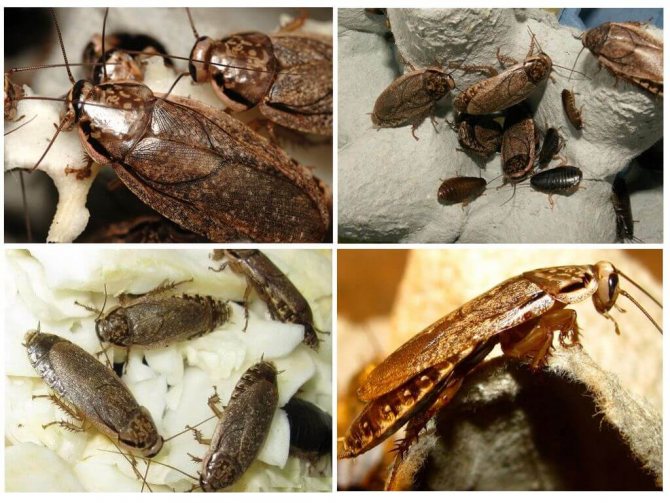

Habitat of marble cockroaches
What are the Prussians afraid of
Everything that the Prussians are afraid of either threatens their life, or makes it uncomfortable, or immediately kills them, therefore all possible ways of exterminating them are based on these weaknesses of insects. The Prussians are afraid:
- Bright light
- Cold below -5 degrees
- Heat above +45 degrees
- Lack of water for more than 10 days
- Lack of food for more than 2 months
- Insecticides


The most modern, easiest and fastest way to destroy the Prussians is to use chemicals for crawling insects. You can try to do local treatment yourself. If it is necessary to clear the entire apartment of cockroaches, it is more advisable to immediately seek help from the SES.
Meal worm, or Large flour beetle (lat.Tenebrio molitor)
Due to the ease of breeding, they appeared with me very first. It turned out to be easy to gather information, and at first the worms settled in a simple container. The result turned out to be good: even in relatively Spartan conditions, they bred steadily.
But over time, nevertheless, some rules of their more productive content appeared: The container should be flat; The main thing is width, not height.
These insects do not know how to crawl along the walls of the container in any form, and therefore it is this shape of the box that is optimal for them. A hole should be made in the container lid itself and a mosquito net should be attached.


Option for attaching the mosquito net to the container.
Filler
At the beginning of their detention, they had flour and oatmeal poured, but then it turned out that the way of life of mealworms is a little more complicated than just burying in the ground, and subsequently several fillers were used. The priority is still given to flour of various types - rye, wheat, coarse grinding - it occupies about 50% of the litter. Oatmeal comes next, and old muesli is also used (optional). Then from the main components - sawdust and coconut substrate. This is a great addition to add looseness and interesting texture to adult beetles. You can also add corn filler. Moreover, the beetles perfectly eat the components of the litter, so if you forget to feed them, nothing bad will happen, they will successfully eat sawdust.
There is an opinion that levels should be made of paper in the container, since the life cycle of a beetle includes an adult beetle that lives on the surface, a larva (actually a mealworm) that crawls everywhere, and a pupa that pupates in the lower layers. Newspapers and magazine paper are used to create them. However, in the case where the levels are created by kitchen napkins, the latter are quickly eaten, leaving only the top layer. It can be used to "catch" worms. Khrushchak likes to sit just under large flat sheets. This can be a dried-up piece of peel, which will certainly remain if you put fruit on the worms, or a piece of napkin under which they are stuffed. And by lifting it, you can get several worms at once, there is no need to dig into the filler to find a treat for the birds.
The filler does not get dirty for a very long time, so you can change it from time to time.
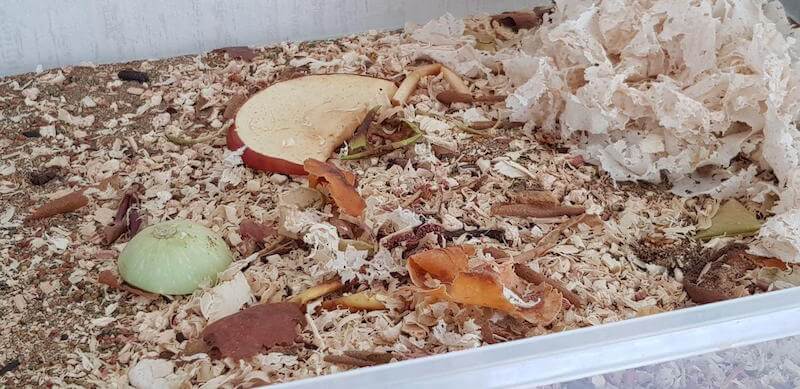

Non-eaten pieces of fruits and vegetables, as well as skins that insects do not eat, also become a filler.
Humidity and light
Insects do not require high humidity and live under normal room conditions. But it is advisable to place the container where direct sunlight does not fall.
Feeding
In addition to the fact that the beetles themselves live in their own food, they should be specially fed with juicy food. You can give pieces of fruits and vegetables, yesterday's meal of insectivorous birds. It is imperative to give protein foods such as meat, fish, gammarus, daphnia. Worms don't eat too much, and you can feed them as much as possible, without a special schedule. They also eat dead beetles and molted skins. It is better to spread the food over the entire surface of the container so that everyone can get it.
They also put sepia and a mineral stone, which they eat with pleasure.
Sepia (cuttlefish shell) gnawed by a mealworm.
Additional drinking bowls or water tanks do not need to be installed.
To easily get a large amount of tormentor at a time, it is best to wait for them to gather under a piece of food.
As food, they are wonderful insects: they are easy to keep and easy to breed. Birds eat these insects at any stage of their development.



